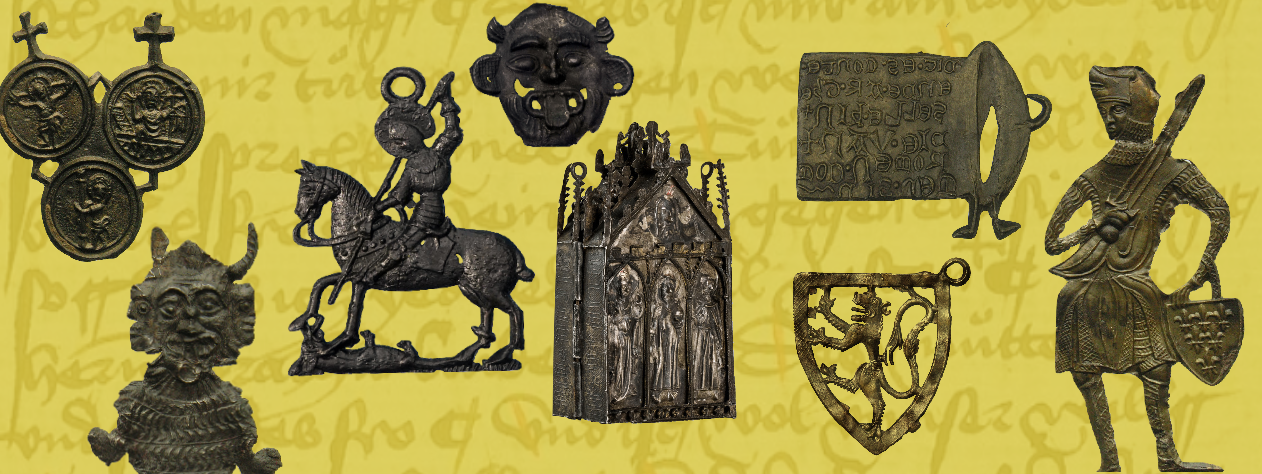Margery Kempe and Pilgrim Badges
Today marks the commemoration day of a remarkable English mystic, Margery Kempe, a middle-class, medieval woman born in what is now King’s Lynn, Norfolk around 1373, where she died after 1439. We know of Kempe’s life through the chance discovery of her dictated work, The Book of Margery Kempe, in the twentieth century. From her Book, which is considered the first autobiography written in English, we learn that Kempe was married and bore fourteen children before negotiating a chaste marriage. After the birth of her first child, Kempe suffered from demonic visions before having a saving vision of Christ. The heart of Kempe’s Book is her love for God: her visions of Christ, the grand tears she wept for him, her afflictions for his love, and the many religious pilgrimages she undertook where these accounts took place.
Kempe is an interesting case study for medieval badges because, as a medieval pilgrim, she visited some of Europe’s most famous pilgrimage sites – sites where pilgrim badges were certainly present and in circulation during her fifteenth-century journeys. Despite this, no mention is made to pilgrim badges in her Book. Over the next few blog posts, I will question this omission: Did Margery Kempe collect pilgrim badges but omit discussing them when dictating the Book? Or did she not participate in this practice?
To collect or not to collect?
Because no mention is made to pilgrim badges in her Book, pursuing the connection between Kempe and badges depends not on the question’s answerability but on its possibility. Our speculation, however, is not without clues. Kempe discloses herself to readers in her Book in both practical and personal ways. Practically, we have information about where and when she went on pilgrimage. These details are important because they can be cross-referenced with data on surviving badges to determine the kind of badges that would have been available to Kempe at specific sites and times.
In thinking this question through, I wrote to Dr. Anthony Bale, whose translation of and notes for The Book of Margery Kempe have helped my research. I asked Dr. Bale whether he thought Margery Kempe would have collected pilgrim badges, and he replied that he did:
My feeling is that pilgrim badges were so cheap and ubiquitous in places like Rome, Santiago, Wilsnack and Aachen, that Kempe would certainly have bought them. They were likely not even worth recording - although she does mention in passing other pilgrimage souvenirs like her walking stick from the holy land.
In his reply, Dr. Bale pointed me to surviving badges that were found in Lynn and are now housed in the Thomas Pung Collection in Lynn Museum, illustrating that “pilgrim badges from the places visited by Kempe were common in Lynn.” For example, of the two surviving Wilsnack badges found in England, where Kempe visited during her pilgrimage to Prussia, one of them was found in King’s Lynn.
So, it is likely that a pilgrim like Kempe would have participated in an economy of pilgrim badges – but was Kempe a normal pilgrim? Dr. Anne E. Bailey calls Kempe’s established identity as a pilgrim into question in her article, “The Problematic Pilgrim: Rethinking Margery’s Pilgrim Identity in The Book of Margery Kempe.” If Kempe does not refer to herself as a pilgrim in her Book, perhaps she would not have wanted to identify as one visually on pilgrimage; what use would these badges then have had? I wrote to Dr. Bailey asking her thoughts on my research question. Not committing herself to either side, Dr. Bailey wrote back with her own speculations:
[I]f you follow the logic of my article (and I’m quite open to challenges!) in which I argue that Margery saw herself as being spiritually superior to the common crowd, I suppose you could also speculate that she might avoid the more commercial, popular aspects of pilgrimage such as souvenir buying. If her direct relationship with Christ is the crux of her religiosity, perhaps pilgrim badges were irrelevant? One might even argue that her Book acts as a kind of pilgrim badge: it’s a record and memento of her journeys.
Another thought: did any of the female saints and mystics Margery so admired, and tried to emulate, go on pilgrimage and purchase pilgrim badges? If they didn’t mention pilgrim badges, this may be one reason for Margery’s silence.
Dr. Bailey’s proposal that the Book itself acts as a pilgrim badge is provocative and puts forth questions of the difference between keeping visual mementos or creating textual ones. What if Kempe did both? For the sake of my coming blog posts, I assume that she did. I will trace Margery’s three large pilgrimages – the first great pilgrimage (1413-1415), the pilgrimage to Santiago (1417-1418), and the pilgrimage to Prussia (1433-1434) – to reimagine which of the surviving badges available at those times Margery may have seen and potentially purchased.
Throughout the series, my research question remains in the air: Did Margery Kempe collect pilgrim badges but omit discussing them when dictating the Book? Or did she not participate in this practice? What do you think?
Works Cited
Bailey, Anne E. Personal Correspondence, 24 October 2022.
Bailey, Anne E. “The Problematic Pilgrim: Rethinking Margery’s Pilgrim Identity in The Book of Margery Kempe.” The Chaucer Review, vol. 55, no. 2 (2020): 171-96.
Bale, Anthony. Personal Correspondence, 23 October 2022.
Kempe, Margery. The Book of Margery Kempe. Translated with an introduction and notes by Anthony Bale. Oxford: Oxford University Press, 2015.
Written by Hannah Gardiner. Edited by Dr. Ann Marie Rasmussen.



